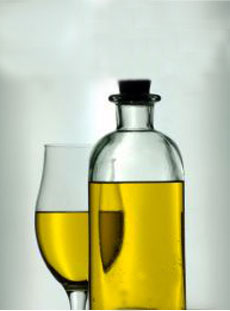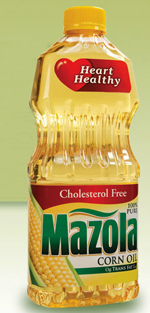

Look for a cooking oil so healthy, you can drink it. (Two tablespoons of olive oil per day are a heart-healthy recommendation.) Photo by Ramon Gonzalez | SXC.
November 2006
Last Updated October 2012
|
 |
Cooking Oils
Page 2: Types Of Cooking Oil ~ C & D
This is Page 2 of a six-page glossary of cooking oils. Click on the black links below to visit other pages. See all of our delicious food glossaries.
 CANOLA or RAPESEED OIL CANOLA or RAPESEED OIL
Canola oil, a trademarked cultivar of rapeseed (a plant in the turnip family, no relation to grapeseed), became a favorite of healthcare professionals in the 1990s, when studies claimed that it had the ability to lower the risk of heart disease. Canola oil has a bland flavor, which makes it a good cooking oil for spicy dishes (e.g. Chinese, Indian and Thai) or delicate dishes where the flavor of the oil is not wanted. It can be used in sautéing, as a marinade and in low-to-medium-temperature stir-frying (it is best to use a different type of oil for high-temperature frying). It doesn’t have enough flavor to be used in a salad dressing. It is a healthy oil, but has the potential to become rancid more quickly than other oils.
CHILE OIL or CHILI OIL
Culinary oil is generally vegetable oil that has been steeped with hot chiles. Traditionally, chile oil has been an Asian product used to flavor various dishes from stir-frys to condiments. However, with the growing interest in hot foods in the U.S., specialty producers are now making gourmet chile oils using olive oil and higher quality chiles, e.g. jalapeños and habañeros, that provide flavor as well as heat (see our review of Gil’s Habañero Tequila Olive Oil). While Asian chile oil should not be used as a cooking oil or the flavor will overpower the food, gourmet chile oils are often fashioned so that they can be used entirely to dress a salad, marinate meat, drizzle on vegetables, et al. See our Chile Glossary to learn more about the different types of chiles.
 COCONUT OIL COCONUT OIL
Coconut oil is a light-colored oil pressed from the meat of the coconut. At room temperature, it solidifies and has a buttery texture. It is produced primarily in India, Indonesia and the Philippines, and is very popular in India and throughout Southeast Asia. It has traditionally been used in cookies, candies, ice cream, whipped toppings and nondairy coffee creamers. Hydrogenated coconut oil, which has been used in American snack products, is unhealthy and should be avoided. Extra virgin coconut oil shows more promise. It is 90% saturated fat; yet, several studies indicate that the saturated fat in coconut oil metabolizes in the body similar to an unsaturated fat and as a result, LDL (bad) cholesterol will not increase. Regardless of what you read, the jury is still out on this so use extra virgin coconut oil sparingly.
COLD EXTRACTION
One of the two methods for extracting oils. Oils obtained from cold extraction may be cold pressed or vacuum extracted. No chemicals or solvents are used as an aid in extracting the oil, ensuring that the oil is the best-tasting possible. The oils are flavorful and expensive, but tend to have lower smoke points than heat-extracted oils (macadamia nut oil, which is cold-extracted, has a very high smoke point). See also Heat Extraction.
COOKING OIL
A cooking oil is a culinary oil with properties that are best for cooking, as opposed to a salad oil or finishing oil. Cooking oil requires a high smoke point. If an oil has a low smoked point, prolonged exposure to heat, while pan-frying or stir-frying, for example, cause the oil to break down, burn bitter and begin to smoke and burn. As a comparison, the smoke point of butter is 350ºF, extra virgin olive oil, 410ºF (it will vary depending on the cultivar and processing) and grapeseed oil, 485ºF. Avocado oil and peanut oil have high smoke points (which is why the latter is used in Asian stir-frying). Because heat will break down the fine flavors and aromas of gourmet oils, the most expensive oils, and flavor-infused oils, are not recommended as cooking oils, even if they are flavored grapeseed or avocado oil.
 CORN OIL CORN OIL
An oil extracted from the germ of the corn kernel. Refined corn oil is one of the best oils for frying because it has a high smoke point. It has a light golden color and is almost tasteless and odorless so it is a good choice for baking. It is widely used as a salad oil and it is also the main ingredient in the production of margarine. Corn oil is high in polyunsaturated fats and monounsaturated fats so it is healthier to use than oils with higher saturated fat levels. Corn oil is one of the most common, and inexpensive cooking oils.
CULINARY OIL
An edible oil; one which can be used for baking, cooking, dressings, etc. Flaxseed, for example, produces both culinary oil and industrial oil.
CULTIVAR
A variety of a plant that has been created or selected intentionally and maintained through cultivation. There are thousands of different cultivars of olive, for example. Not all are pressed for oil, because some varieties are not fleshy enough to produce enough oil to be commercially viable.
DEEP FRY or DEEP FAT FRY
The process of cooking food by totally covering in hot cooking fat or oil. This process produces evenly-cooked food with a golden, crisp outside and a moist and tender inside.
Continue To Page 3: Terms From E To K
Go To The Article Index Above

|





 CANOLA or RAPESEED OIL
CANOLA or RAPESEED OIL
 CORN OIL
CORN OIL